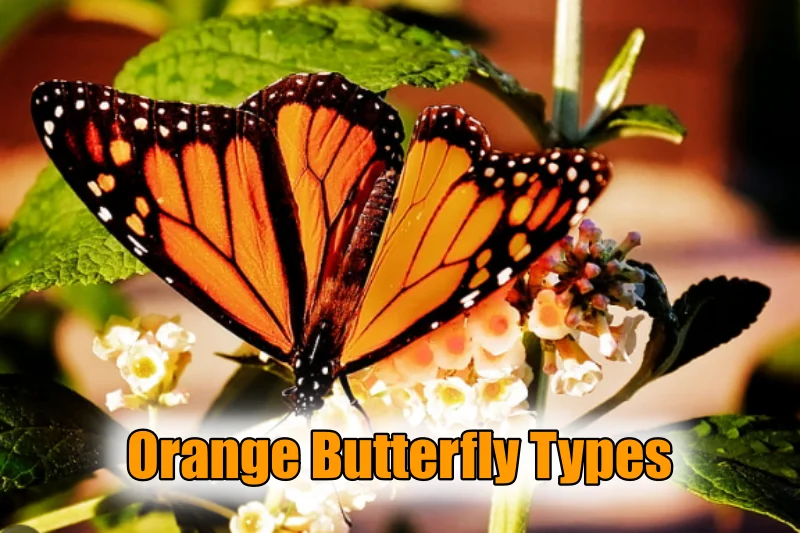When I think of butterflies, the Monarch is undoubtedly the first to grace my thoughts. Their regal appearance, adorned with a perfect blend of vibrant orange and striking black, never fails to captivate people’s attention.
This led me to delve deeper into the realm of orange butterflies. Today I’ve with you a list of 15 orange butterflies from around the world, encompassing both the well-known and the more elusive.
The orange color not only adds to their beauty but is like a natural “danger” sign to keep predators away, signaling their unpalatable nature. Their very appearance and vivid hue are a testament to the genius of nature’s defense mechanisms.
So, without further ado, let’s embark on a journey into the enchanting world of fluttering orange butterflies.
15 Uncommon Orange Butterfly Types
1) Monarch butterfly
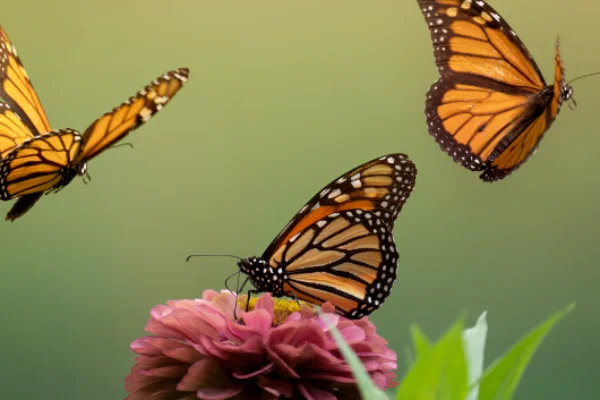
| Scientific name | Danaus plexippus |
| Identification | Easily recognizable back, orange patterned wings with white markings near the edges. |
| Geographic location | North, Central, and South America as well as Australia, some Pacific Islands, India, and Western Europe |
The monarch butterfly, with its striking black, orange, and white wings, is like the royalty of the butterfly world.
It is named to pay homage to King William III of England.
Monarch butterflies possess a remarkable ability to perceive colors based solely on their wavelength, a phenomenon known as “true color vision.”
Human activities, such as car strikes and habitat changes, pose threats to these beautiful butterflies.
2) Goatweed leafwing
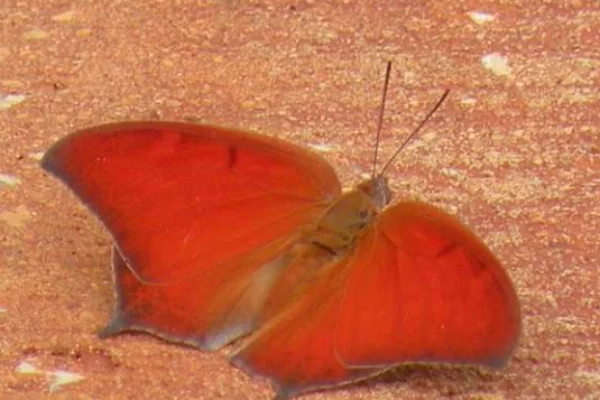
| Scientific Name | Anaea andria |
| Identification | The forewings are hooked while the hind wings are short and pointed. |
| Geographical Location | North America |
Females display an irregular lighter submarginal band and broader darker margins. The forewing exhibits a distinctive hook (falcate), and both hindwings boast short, pointed, backward-projecting tails.
When handled, adult butterflies often play dead, as the undersides of their wings are designed to mimic dead leaves, providing excellent camouflage.
In flight, goatweed butterflies are known for their swift and erratic movements, adding to their allure.
3) African Queen
| Scientific name | Danaus chrysippus |
| Identification | Bright yellow-orange wings with white and brown markings |
| Geographic location | Found in several regions of Asia, Australia, and Africa. |
The African Queen or the plain tiger butterfly, has beautiful orange-brown wings adorned with elegant black and white patterns.
In an interesting twist of nature, the butterfly feeds on a milkweed diet, making it an unpalatable mouthful for its predators.
A 3,500-year-old ancient Egyptian fresco in Luxor showcases the timeless beauty of this species. It is believed to be one of the first butterflies depicted in art.
4) Julia butterfly
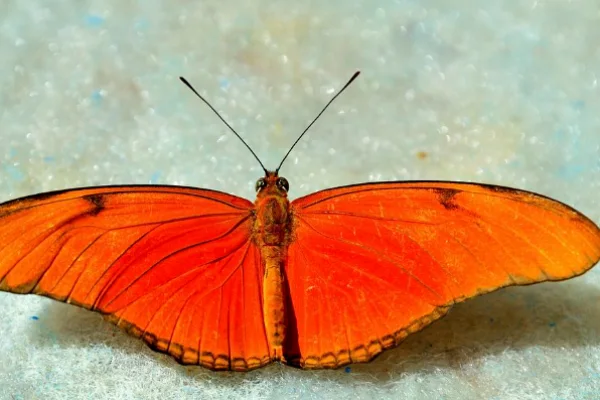
| Scientific name | Dryas iulia |
| Identification | Bright orange wings with black markings |
| Geographic location | Native to Brazil |
The Julia butterfly is known for gatherings on damp ground and engaging in mud-puddling behavior.
These butterflies use their wings to agitate the eyes of caimans and turtles, causing them to produce tears, which the butterflies sip on.
Males put on an aerial show to attract females, with intricate steps and wing beats.
The larvae of the butterfly release toxic chemicals feeding on the hostplant containing trace levels of cyanide making them unpalatable to their predators.
5) Regal fritillary
| Scientific name | Speyeria idalia |
| Identification | Stark resemblances to the monarch butterfly |
| Geographic location | East-central United States |
Regal Fritillary has a striking deep orange color and contrasting dark hindwings adorned with white spots.
Even as tiny larvae, they survive the harshest of weather conditions to emerge as a beautiful butterfly.
They are known to feed exclusively on various violet species like bird’s-foot violet and Johnny Jump up.
6) Great spangled fritillary
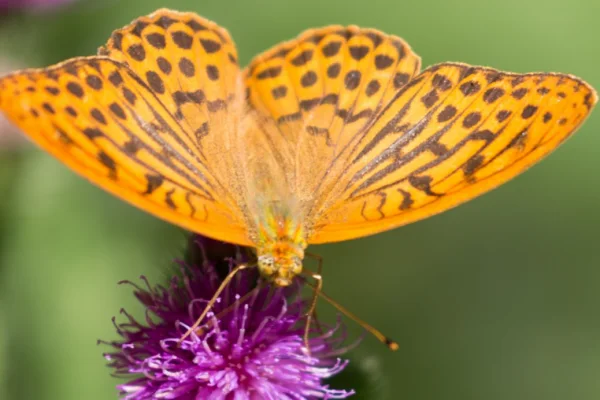
| Scientific name | Speyeria cybele |
| Identification | Orange and brown butterfly with black markings on the edges |
| Geographic location | North America |
The Great Spangled Fritillary has fiery orange wings with dashes and crescents of black.
They also showcase sexual dimorphism in terms of their appearance, the females tend to be darker and brighter than the males.
The round-leaf violet (Viola rotundifolia), the arrow-leaf violet (Viola fimbriatula), and the common blue violet (Viola sororia) serve as host plants for these species.
7) Nokomis fritillary
| Scientific name | Speyeria nokomis |
| Identification | Forewings are brightly orange-colored with brown and white marking |
| Geographic location | North America |
Nokomis fritillary belongs to the species of fritillary from the family of butterflies known as Nymphalidae
Nokomis fritillary displays sexual dimorphism, while males have a brownish-orange coat adorned with dark patterns, the females have predominantly black wings, with cream-colored spots.
It has a network of dark veins crisscrossing its wings, giving the butterfly’s vibrant orange and black wings a unique character.
8) Blue spot pansy
| Scientific name | Junonia westermanni |
| Identification | Black wings with distinct orange spots on both forewings and hindwings and blue markings on the inner corners |
| Geographic location | Central Afrotropical regions |
The blue spot pansy has a wingspan of about 25 mm with distinct orange and blue markings on both its forewings and hindwings.
The larvae are known to feed on various plants, including Asystasia, Brillantaisia, Barleria, Justicia, Eremomastax, Ruellia, and Pupalia.
Despite its small size, the Blue Spot Pansy leaves a big impression in the central part of the Afrotropical realm.
9) Grecian shoemaker
| Scientific name | Catonephele numilia |
| Identification | Males are black with six orange dots on the dorsal surface, while females are black with a yellow band across the center of the forewing. |
| Geographic location | Central and South America |
Also known as the Blue-Frosted Banner, a vibrant orange butterfly hailing from Central and South America.
It exhibits sexual dimorphism, with males donning a sleek black coat adorned with six eye-catching orange dots on their wings. While the females have a more elegant look, featuring black wings with a light-yellow band on the center of their forewings.
In their adult stage, they can be spotted indulging in the nectar of rotten fruits.
10) Eastern red lacewing
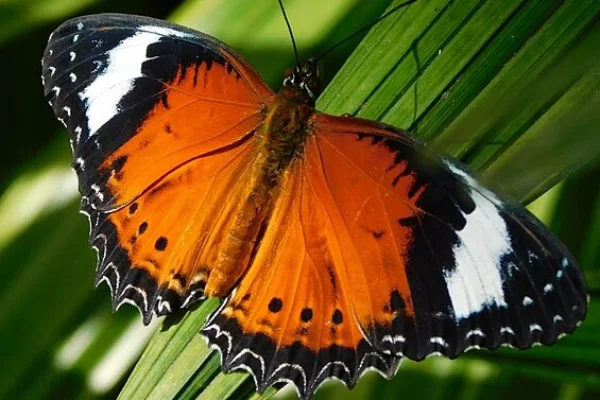
| Scientific name | Cethosia cydippe |
| Identification | Orange butterfly with thick black edges and distinct white markings on the forewings. |
| Geographic location | Found in Australia, New Guinea, and nearby islands |
The red lacewing has vibrant red wings, outlined by bold black edges with a white patch on its forewings.
The Eastern Red Lacewing begins its life as tiny pale-yellow eggs laid in clusters of up to 50.
These butterflies feed on vines from the Passifloraceae family, including the lacewing vine and the Queensland passion fruit.
11) Boisduval’s false acraea
| Scientific name | Pseudacraea boisduvali |
| Identification | Wings are orange-yellow with black distinct dots and brown edges |
| Geographic location | Ranges from the tropics and subtropics of sub-Saharan Africa |
With a wingspan ranging from 65 to 88 mm, this butterfly displays an amazing blend of colors and patterns.
It boasts striking orange to red-yellow hindwings, adorned with a bold black, red-spotted marginal band. The forewings feature semi-transparent areas and thick black longitudinal streaks.
Its presence in various areas showcases its adaptability to different habitats and climates across the continent.
Their larval stage is known to feed on the foliage of several plant species within the Sapotaceae family, including Chrysophyllum, Mimusops, Manilkara discolor, and Englerophytum.
12) Red cracker
| Scientific name | Hamadryas amphinome |
| Identification | The dorsal side has distinct blue and black patterns with orange markings on the forewings with its underside being prominently orange. |
| Geographic location | North and South America |
These vibrant butterflies wander to regions including Mexico, Brazil, the Guianas, Peru, and even as far south as Argentina.
The Red Cracker has several subspecies spread across Costa Rica and Brazil like “amphinome,” “fumosa,” and “mexicana,” with each having its unique geographic footprint and characteristics.
The subspecies “mexicana” is most abundant on the Pacific coast, adding a vibrant burst of colors to the region.
13) Eleus orange forester
https://in.pinterest.com/pin/492649943764572/
| Scientific name | Euphaedra eleus |
| Identification | Orange butterfly with thick black edges and white spots |
| Geographic location | Central and southern African countries |
Eleus orange forester is spread across Africa with a range that includes Guinea, Sierra Leone, Liberia, Ivory Coast, Ghana, Nigeria, Cameroon, Gabon, Congo, Angola, Uganda, and more!
Their wings are a mix of orange, red, and yellow with the undersides of their wings featuring a striking contrast with dark orange backgrounds and white patches.
With their reddish-brown wings, they cleverly mimic the day-flying moth Scopula helcita.
14) Gulf fritillary
| Scientific name | Dione vanillae |
| Identification | Yellow-brown wings with black and white markings |
| Geographic location | Southern areas of the United States |
The Gulf Fritillary, with its striking wings of deep orange and black streaks, is a sight to behold in the blue skies.
When they sense danger, they release a smelly chemical signal to warn predators not to approach.
This butterfly undertakes two major migrations each year, first in the spring when large populations of Gulf Fritillaries head northward. The second migration takes place in the fall as they return southward.
When a male encounters a female, he clasps its wings together, releasing pheromones that play a vital role in attracting and courting potential mates.
15) African giant swallowtail
| Scientific name | Papilio antimachus |
| Identification | Wings are narrow and orange-brown with black markings |
| Geographic location | Western and Southern African countries |
With a wingspan ranging from 7.1 to 9.1 inches, the African giant swallowtail holds the title of the largest butterfly in Africa and one of the largest in the world.
The African giant swallowtail has long, narrow wings with orange-brown hues adorned with bold black markings.
You can spot them in the tropical rainforests of West and Central Africa ranging from countries like Angola, Cameroon, the Democratic Republic of the Congo, Gabon, Ghana, Ivory Coast, Liberia, Nigeria, Sierra Leone, and Uganda.
Males of this species are often spotted congregating near mud puddles, while the females tend to be more elusive, spending their time high up in the sky.
Conclusion
With this, we’ve reached the end of article on the marvelous world of 15 Uncommon Orange Butterfly Types. With this article, we’ve taken a closer look at the various shades and designs of orange butterflies that you can find all around you. Tune in to quench your thirst for knowledge with HowItSee as we bring to you fresh articles every single day! Stay tuned for further exploration of our world’s wonders.
Frequently Asked Questions
1) What does the orange butterfly symbolize?
The orange butterfly symbolizes positive energy, joy, happiness, playfulness, and spiritual guidance. Orange butterflies are also seen as symbols of evolution, perseverance, and enlightenment. They remind us to follow our soul’s calling, embrace transformation, and live a more meaningful and enlightened life.
2) Is the orange butterfly rare?
While some orange butterflies are common, others may be relatively rare. The prevalence of orange butterflies can vary depending on the species and geographic location.
3) What kind of butterfly is all orange?
The Monarch butterfly (Danaus plexippus) and the Gulf Fritillary (Agraulis vanillae) are two of the most well-known butterflies that are primarily orange in color.
4) Where do orange butterflies live?
Orange butterflies can be found in various regions around the world. Their habitats range from meadows and woodlands to tropical rainforests, depending on the species.
5) Is butterfly good luck or bad luck?
Butterflies are generally considered symbols of good luck and positive change in many cultures. Their transformation from a caterpillar to a beautiful butterfly is often associated with personal growth and positive life changes.
6) What color butterfly means lucky?
In many cultures, a white butterfly, such as the Cabbage White butterfly, is often considered a symbol of good luck. White butterflies represent purity, new beginnings, and positive transformation.
Also Read:

Hi everyone, my name is Shawna, and I’ve always been fascinated by the fascinating diversity of flora and fauna that our nature has in it. I am currently studying biotechnology and am particularly interested in animal biotechnology, delving into the intricate processes that define their true nature and uniqueness.
